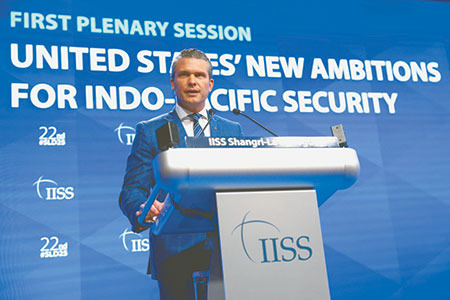
A top Pentagon official, speaking at the Shangri-La Dialogue in Singapore in late May, delivered a stark message regarding China’s growing influence, asserting that the United States will not be displaced from the Indo-Pacific region and will prevent its allies and partners from being subordinated or intimidated. While stating Washington does not seek to suppress Beijing, the official emphasized that should deterrence against China fail, America is prepared to “fight and decisively win.”
This declaration underscores a robust and consistent U.S. strategy aimed at counteracting Beijing’s expanding military and economic footprint across the World’s Oceans, with a particular focus on the Pacific. Washington is employing a comprehensive suite of military-political and economic measures to curtail China’s rising influence, a policy line that has demonstrated notable continuity across different U.S. administrations, reflecting a broad consensus on the strategic challenge posed by Beijing.
A cornerstone of this U.S. approach is the construction of a multi-layered deterrence system. This involves a network of military bases and strong politico-military alliances. The first, or inner, perimeter of this strategy heavily involves Japan and the Philippines. Following a trilateral summit in Washington in April 2024, solidifying cooperation, the Philippines has become a key hub for U.S. military presence, hosting an expanding network of American facilities, including new sites for naval, army, and air force operations. Notably, the Pentagon deployed mid-range MRC Typhon missile systems in April 2024 and NMESIS coastal defense missile systems in spring 2025 to the Philippines, moves openly described by Washington as aimed at militarily deterring China. Japan, home to the U.S. 7th Fleet and approximately 54,000 U.S. troops—the largest contingent stationed abroad—is also central to this strategy, with ongoing efforts to create a more unified U.S.-Japan joint operational command.
The second, or middle, strategic perimeter encompasses island nations in Micronesia, including the Federated States of Micronesia, the Marshall Islands, and Palau. In March 2024, the U.S. Congress approved $7.1 billion to fund 20-year agreements known as Compacts of Free Association with these nations, ensuring continued U.S. military-political access and influence. These islands form a strategic chain with Guam and Hawaii, which host crucial U.S. naval bases. The U.S. maintains significant facilities in the Marshall Islands, such as the Ronald Reagan Ballistic Missile Defense Test Site.
Further afield, a third, or outer, perimeter features Australia as a southern bastion, alongside Papua New Guinea and Vanuatu. U.S. military ties with Canberra are developing both bilaterally and through the trilateral AUKUS security pact, which includes the United Kingdom. Australia hosts a network of U.S. military and intelligence facilities, such as the Pine Gap satellite surveillance base and a U.S. Marine Corps rotational deployment base in Darwin. Washington is also focused on enhancing Australia’s own military capabilities under AUKUS.
Beyond these perimeters, the U.S. is actively working to prevent Chinese strategic inroads into the southwestern and southern Pacific, particularly among the island nations of Melanesia and Polynesia. This focus aims to secure the rear areas of its Micronesian defense line and mitigate potential threats to Australia’s eastern approaches. Intense diplomatic pressure was applied to the Solomon Islands after it signed security and policing cooperation agreements with Beijing in 2022 and 2023. Washington and Canberra viewed these as potential precursors to Chinese military basing. Consequently, Honiara publicly ruled out hosting Chinese bases, and the U.S. reopened its embassy there in February 2023, while Australia offered to help build the Solomon Islands’ own military.
Similar contests for influence are unfolding elsewhere. The Cook Islands signed a comprehensive strategic partnership plan with China in February of this year, drawing concern from New Zealand and likely prompting further diplomatic engagement from Washington and Canberra. In Vanuatu, the U.S. appears to have preempted deeper Chinese engagement by establishing its own embassy in Port Vila in 2024, deploying a maritime threat data processing center, and having the U.S. Coast Guard assist in protecting Vanuatu’s exclusive economic zone. Likewise, in May 2023, the U.S. signed a security cooperation agreement with Papua New Guinea, granting American forces unimpeded access to its territorial waters, airspace, and ports.
Parallel to these military and diplomatic maneuvers, Washington is also challenging China on the trade and economic front, specifically targeting its port and logistics infrastructure. The objective is not only to displace Chinese influence from strategically vital locations but also for the U.S. and its allies to offer alternatives. Illustrating this, the Australian government, under Prime Minister Anthony Albanese, announced in April its intention to regain national jurisdiction over the Port of Darwin, which was leased to a Chinese company in 2015 for 99 years. This move, long advocated by Washington, is seen by some observers as a step towards potentially accommodating U.S. naval assets in the future.
